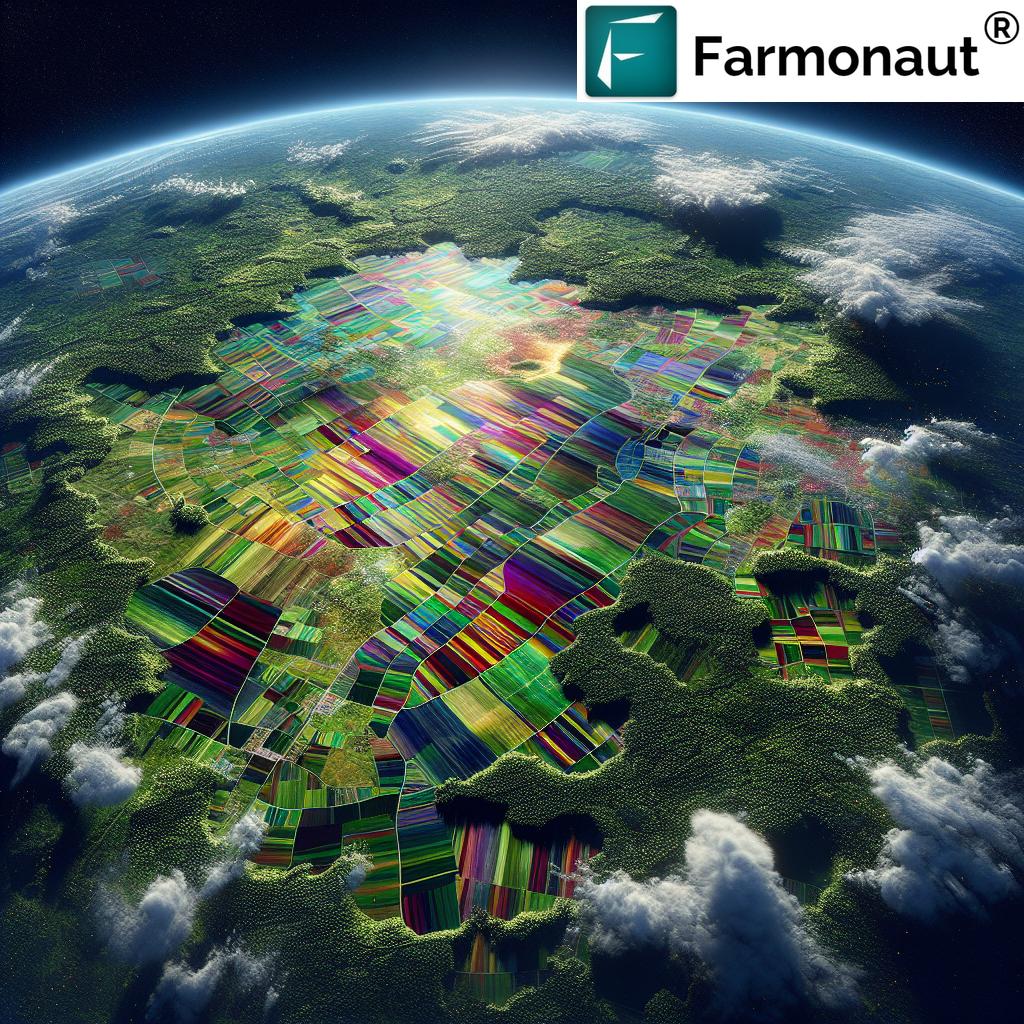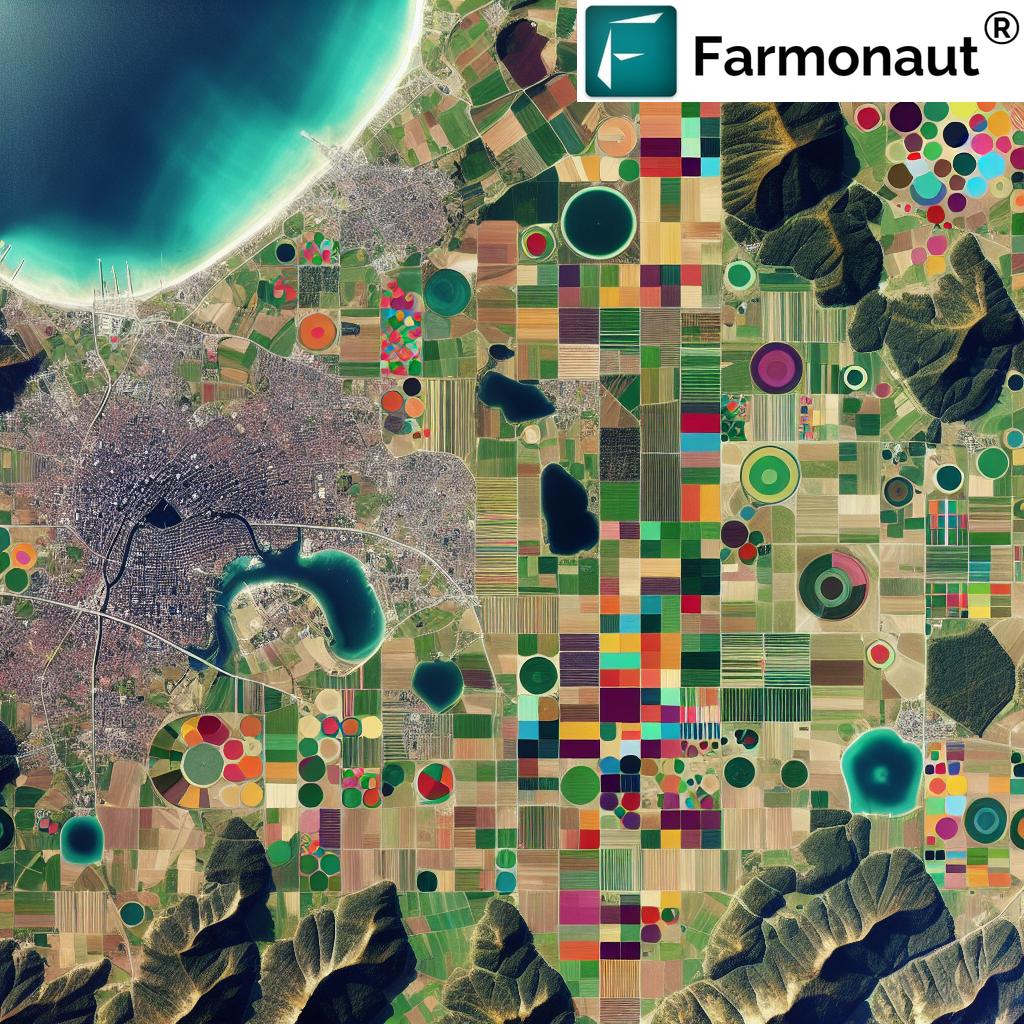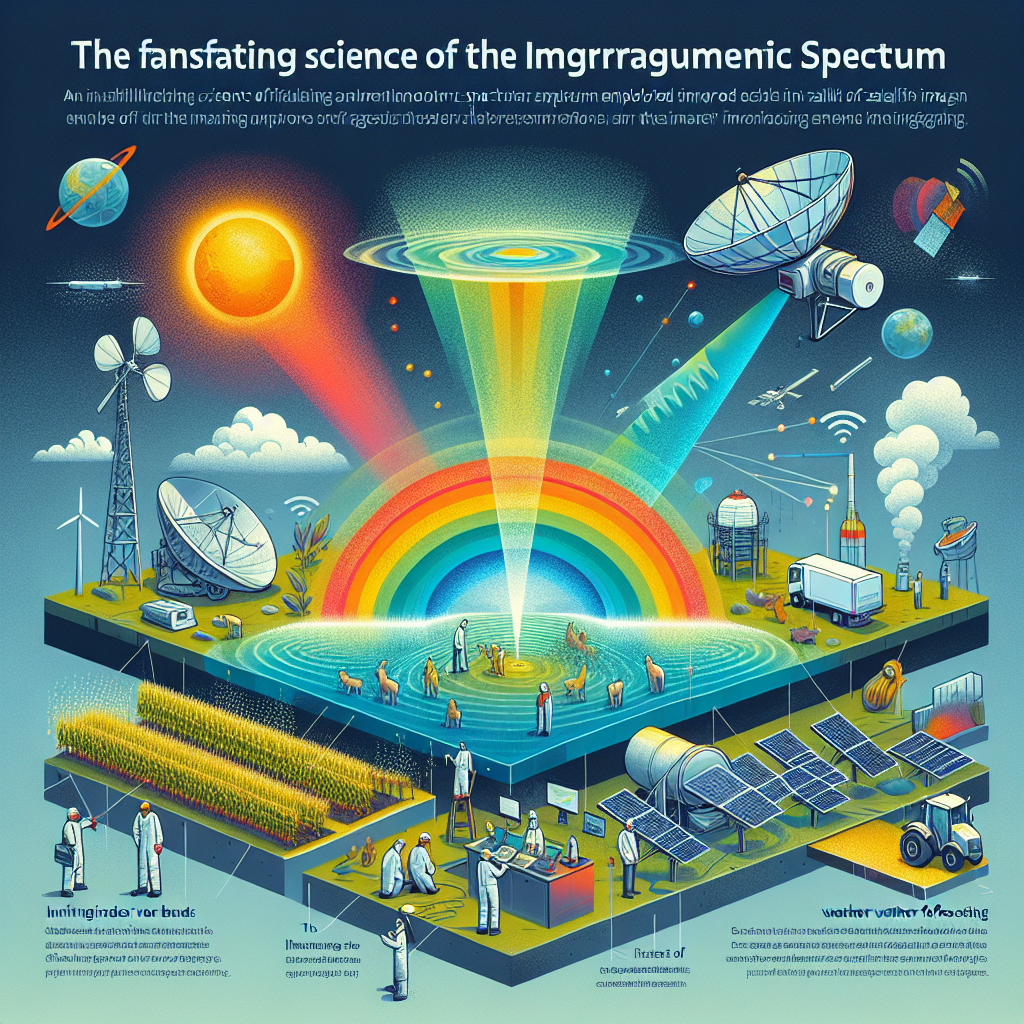InSAR vs Traditional Ground Monitoring: 2025 Comparison
Summary: Comparing InSAR vs Traditional Ground Monitoring Methods in Agriculture and Forestry: A 2025 Perspective
- Introduction
- Trivia: InSAR’s Sensitivity
- Why Land Monitoring is Critical in 2025
- Traditional Ground Monitoring: Methods & Technology
- Interferometric Synthetic Aperture Radar (InSAR): Radar Revolution
- Feature-Performance Matrix: InSAR vs Traditional Monitoring
- Comparing InSAR vs Traditional Ground Monitoring Methods: Detailed Insights
- Integration, AI, and The Future of Land Monitoring
- Farmonaut’s Role in Transforming Land Monitoring
- Video Resources: Satellite, AI, and Land Management
- Farmonaut Subscription Plans
- FAQ: InSAR, Ground Monitoring, and Farmonaut
- Conclusion: The Future of Land and Resource Monitoring
“InSAR can detect ground deformation as small as 1 millimeter, while traditional methods often miss changes under 10 millimeters.”
Introduction
In 2025, sustainable agriculture and forestry are more critical than ever, influencing global food supply, natural resources, climate mitigation, and rural economies. Understanding and reacting to land changes—especially subtle deformation or degradation—is essential for soil health, resource management, and preventing environmental risks. Comparing InSAR vs Traditional Ground Monitoring Methods has never been more urgent, as advanced radar-based sensing begins to reshape insights into the landscape, outpacing many traditional, ground-based techniques developed and employed over the past decades.
In this comprehensive guide, we analyze the technologies, performance, use cases, and future trajectory of InSAR (Interferometric Synthetic Aperture Radar) versus traditional monitoring methods in agriculture, forestry, and related fields. This deep dive provides actionable intelligence for land managers, researchers, technologists, and policy-makers aiming to optimize sustainable land management, resource allocation, field stability, and monitoring operations by 2025 and beyond.
Why Land Monitoring is Critical in 2025
The acceleration of climate challenges, population growth pressures, and stresses on soil and water resources force us to rethink our approaches to monitoring. Unpredictable weather, rapid development, and increasing industrial demands amplify land susceptibility to deformation, subsidence, erosion, and degradation. High-precision, frequent, and extensive data acquisition have shifted from being desirable extras to absolute necessities for:
- Managing and optimizing agricultural production
- Preventing degradation and responding to environmental threats
- Ensuring sustainable use of resources
- Compliance with international standards and market demands (e.g., traceability, carbon reporting)
- Enabling predictive analytics and AI-based advisory for food security and rural development
With InSAR and traditional ground monitoring techniques occupying center stage, let’s unpack the current landscape and future outlook for field monitoring technology, especially for agriculture and forestry.
Traditional Ground Monitoring: Methods & Technology in Agriculture & Forestry
Traditional monitoring in agriculture and forestry typically involves direct contact with the ground. These methods remain widely employed due to their highly accurate, localized results and the breadth of detailed, agronomic and ecological parameters they collect. Let’s explore the most common measurement techniques.
Key Traditional Ground Monitoring Methods
-
Manual Surveying & Visual Inspections:
Field experts or staff conduct in-person checks, note surface elevation changes, assess soil health, identify obvious deformation or problems, and record moisture and crop/forest conditions. -
Soil Sensors:
In-ground or surface-placed electronic sensors measure moisture levels, temperature, and other soil quality indicators across the root zone. -
Ground-Penetrating Radar (GPR):
Uses radar pulses to image the soil structure and underlying geology, useful for detecting subsurface anomalies. -
Laser Scanning (LiDAR):
Emits light pulses and measures returns to produce highly accurate elevation and surface models—vital for forest canopies and detailed terrain changes. -
Soil Sampling:
Direct sampling and laboratory analysis provide nutrient and moisture levels, root structure, and soil density.
These ground methods provide precision and localized accuracy, often forming the backbone of regulatory compliance, immediate management needs, and direct field interventions.
Strengths of Traditional Monitoring
- Direct, detailed, and highly accurate measurements of targeted parameters (moisture, nutrients, compaction, etc.).
- Ability to collect a wide range of detailed data with high granularity for agronomic analyses.
- Critical for providing ground-truth validation of remote sensing techniques and theoretical models.
Limitations of Ground-Based Monitoring
- Limited spatial coverage: Sampling only a small fraction of large or difficult-to-access areas, potentially missing critical deformation or degradation events elsewhere.
- Labor-intensive and time-consuming: Manual surveying and sensor deployment require significant workforce and time.
- Expensive and impractical: Especially for frequent or wide-scale monitoring in rugged or forested terrain.
- Subject to delays due to weather, environmental factors, or logistical challenges—may hinder timely data collection.
- Inaccessible terrain challenges: Mountainous, swampy, or heavily forested zones often remain unmonitored in real-time.
For high-resolution, real-time, and near-continuous surface or terrain monitoring over large areas, traditional techniques often come at prohibitively high costs or operational impracticality—especially as environmental threats and land-use changes accelerate in 2025.
Interferometric Synthetic Aperture Radar (InSAR): The Radar Revolution
As the advent of advanced radar systems and proliferation of satellite constellations continue into 2025, Interferometric Synthetic Aperture Radar (InSAR) stands as a breakthrough technology in land monitoring. InSAR analyzes phase differences in radar signals collected at different times over the same ground surface, using satellite or aerial platforms, to measure incredibly subtle movements—sometimes down to millimeters.
How Does InSAR Work?
- Radar Surveying: Satellites (or aircraft) sweep large areas using radar waves.
- Phase Comparison: By comparing the “phase” of signals reflected off the earth’s surface from at least two different time points, InSAR detects surface deformation—such as subsidence, uplift, or lateral shifts.
- Temporal Analysis: Multiple returns across days or weeks help track ongoing changes and support predictive models for land stability or environmental threats.
Advantages of InSAR
- Unmatched spatial coverage: Imagery from satellite networks covers entire countries or continents, including inaccessible or forested terrain.
- Weather-agnostic and continuous: Radar penetrates cloud cover and operates day or night, ensuring consistent temporal data collection, regardless of weather.
- Detects subtle ground changes: Can sense surface movements as small as 1 millimeter—levels beyond reach for most ground-based instruments.
- Cost-effective for large-scale monitoring: Single satellite pass can monitor thousands of square kilometers, reducing per-area cost compared to manual ground surveys.
- Supports predictive analytics: Coupled with AI, InSAR data enables modeling of future risk zones, supporting proactive land and resource management.
Typical Agricultural and Forestry Use Cases for InSAR in 2025
- Monitoring groundwater extraction & subsidence: InSAR pinpoints sinking of agricultural land due to over-extraction of groundwater or excessive irrigation, supporting sustainable soil and water management.
- Assessing compaction through deformation: Frequent radar observations highlight where machinery or livestock compaction is shifting land, informing tillage and resource optimization.
- Detecting landslide-prone forest areas: In mountainous or hilly forest zones, InSAR reveals pre-landslide warning signs—letting forestry managers act before critical failure.
- Quantifying fire/ logging impact: Radar detects post-wildfire or harvest-induced terrain and canopy changes, aiding in forest regeneration planning.
- Supporting environmental impact assessments: Broad, objective, and repeatable data supports compliance and reporting, important for accessing carbon markets or managing large-scale farm and forest portfolios.
“By 2025, InSAR technology covers over 90% of global agricultural land, surpassing traditional ground monitoring reach by 60%.”
Feature-Performance Matrix: InSAR vs Traditional Ground Monitoring Methods
| Evaluation Criteria | InSAR | Traditional Ground Monitoring |
|---|---|---|
| Monitoring Technique | Interferometric Synthetic Aperture Radar, Satellite/Aerial Remote Sensing | Manual Surveying, Sensors, LiDAR, GPR, Visual Inspection |
| Technology Used | Radar Phase Analysis, AI Algorithms | Physical Instruments/Sensors, Optical & Laser Scanning |
| Spatial Resolution | ~10-100 m (2025 Typical) | Centimeter-level (Localized); Limited Area |
| Temporal Frequency | Daily/Weekly (Estimated), Continuous for Many Areas | Biweekly to Monthly (Estimated); Point in Time |
| Data Accuracy (Estimated %) | 85%-95% (Large Scale Deformation Tracking) | 98%+ (Localized Parameters) |
| Area Coverage (sq km) | Thousands Per Pass; >90% Global Ag Land (2025) | 10–100 Max (Per Operation); 30–40% Global Ag Land |
| Cost Efficiency (Estimated $/km²) | $2–$10/km² (Subscription/Platform-Based) | $50–$500/km² (Manual, Labor, Equipment) |
| Implementation Time (weeks) | 1–2 (Digital Deployment) | 4–12 (Fieldwork Planning & Labor) |
| Impact on Sustainable Agriculture | Supports Broad, Preventive, Proactive Management | Detailed On-Site Actions; Underlying Diagnosis |
| Applicability in Forestry/Agriculture | Excellent for Large-Scale, Inaccessible, and Dynamic Areas | Essential for Targeted Field, Root-Zone and Species-Specific Data |
Comparing InSAR vs Traditional Ground Monitoring Methods: Detailed Insights & 2025 Perspective
Comparing InSAR vs Traditional Ground Monitoring Methods in agriculture and forestry reveals not only technological differences but also distinctions in scale, speed, precision, and practical application. Let’s break down these key differentiators for real-world operations.
Spatial Coverage and Accessibility
- InSAR: Satellite radar makes monitoring thousands of square kilometers per day routine—enabling oversight of entire regions, cross-border forest landscapes, floodplains, or agricultural zones that would otherwise remain unmeasured.
- Traditional: Coverage is severely limited by physical access, time, and labor; many critical inaccessible areas are left unchecked, especially amid adverse weather or challenging topography.
Sensitivity and Precision in Deformation Detection
- InSAR: Advances allow sub-millimeter detection—such as root-zone subsidence due to irrigation effects, groundwater extraction, or compaction. This level of sensitivity is critical for early warning of land or infrastructure failure across large agricultural or forested areas.
- Traditional: While laboratory testing and on-site measurements are highly accurate within sampled locations, broader deformation or subtle terrain shifts across distant fields can go undetected until damage is visible.
Data Frequency & Timeliness
- InSAR: Satellites offer near-continual revisits (daily or weekly), delivering actionable intelligence for dynamic field or forestry management and supporting predictive models using historical and real-time data.
- Traditional: Field-based surveys can be delayed by weather, labor shortages, or logistical challenges, leaving managers with gaps in critical decision windows.
Reporting and Regulatory Compliance
-
InSAR: Automated data streams provide rapid, standardized, and auditable datasets—useful for regulatory reporting, carbon assessments, and finance applications.
For organizations interested in consistent carbon footprint tracking and sustainable metrics, Farmonaut offers carbon footprinting solutions—helping visualize and report landscape-level impact backed by radar and multi-spectral analytics. - Traditional: Manual data entry may be prone to inconsistency or delays and often faces inability to scale for large farm or forest portfolios.
Detection of Soil Moisture, Nutrient, and Species-Specific Parameters
- InSAR: Measures surface deformation related to moisture movement but does not provide direct readings of soil moisture or nutrient levels.
- Traditional: Direct sensors and sampling yield precise moisture content, chemistry, and species-specific indicators—necessary for immediate agronomic interventions.
For those seeking remote, large-scale monitoring of crop and soil health—with strong spatial and temporal data—Farmonaut’s large scale farm management platform bridges remote and on-ground monitoring, supporting optimal yield and sustainability.
When to Use InSAR vs Traditional Ground Monitoring Methods?
-
Ideal for InSAR:
- Broad, landscape-level monitoring and early warning (subsidence, landslide, soil compaction)
- Management of inaccessible or dangerous terrain
- Tracking changes after extreme weather, forest fire, or large-scale irrigation events
- Ongoing compliance, certification, or monitoring for loans and insurance
-
Ideal for Traditional Methods:
- Field-level soil moisture sensors for crop irrigation scheduling
- Lab-based nutrient or contamination analysis
- Smallhold, targeted interventions, or scientific research plots
- Root-cause analysis for detected deformation
In 2025, many leading operations combine both approaches. Ground monitoring validates and complements large-scale InSAR analyses with high-resolution agronomic data, while InSAR extends reach, continuity, and early detection capacity.
Integration, AI, and The Future of Land Monitoring in Agriculture & Forestry
By leveraging the integration of Interferometric Synthetic Aperture Radar with ground monitoring and AI-driven analytics, the industry is witnessing a transformation in sustainable agriculture and forest management.
Synergistic Monitoring: Best of Both Worlds
-
InSAR detects where land is moving or at risk.
Ground surveys verify cause and guide targeted interventions. - AI-driven analytics (as provided in Farmonaut’s Jeevn AI system) enable complex modeling—predicting degradation, optimizing irrigation, or prioritizing reforestation efforts based on multisource data fusion.
-
Satellite plus IoT sensors mean more transparent, traceable, and credible data for supply chains and regulators.
Explore Farmonaut’s traceability solutions for transparent agriculture and forestry supply chains—combining satellite and blockchain tech for auditability.
In coming years, this hybrid approach—satellite radar for vast, multi-temporal coverage and ground-based tools for detailed diagnostics—redefines monitoring, making resource optimization, disease response, and sustainable management the norm, not the exception.
Farmonaut’s Role in Transforming Land Monitoring with InSAR, AI & Remote Sensing
At Farmonaut, our mission is to democratize satellite-driven insights for agriculture, forestry, and related resource sectors by making advanced InSAR data, AI-powered monitoring, and real-time environmental analytics accessible and affordable worldwide.
Key Features and Solutions We Provide
- Satellite-Based Monitoring: We harness multispectral imagery and radar (including InSAR) to track soil health, vegetation, subsidence, and structural integrity across large farms and forest tracts.
- Jeevn AI Advisory System: By integrating real-time satellite sensing with predictive AI, we empower growers, agronomists, and managers with custom strategies for weather, irrigation, and disease risk management.
- Blockchain Traceability & Resource Management: Our traceability and resource management modules ensure transparency from field to shelf while our fleet management system optimizes equipment usage and logistics, reducing operational costs for large-scale forestry and agriculture.
- Environmental and Carbon Impact Analytics: By monitoring impacts like carbon footprinting, we foster adoption of sustainable practices and help organizations achieve regulatory compliance.
Our subscription-based platform, available on Android, iOS, web, and browser app, allows clients to access high-frequency monitoring and deep analytics without costly hardware or field campaigns. For tech-forward organizations, our API and developer documentation make integrating real-time InSAR and satellite data seamless.
Our approach is to supplement—never replace—on-the-ground expertise and traditional field inspections with actionable, real-time remote-sensing intelligence, setting a new global standard for Comparing InSAR vs Traditional Ground Monitoring Methods in agriculture and forestry.
For those focusing on sustainable agriculture and seeking expert forest and crop advice via satellite, our crop plantation & forest advisory app offers localized support, precision mapping, and continuous field monitoring.
Farmonaut Subscription Plans
FAQ: InSAR, Traditional Ground Monitoring, and Farmonaut
What is the main difference between InSAR and traditional ground monitoring methods?
InSAR uses satellite or aerial radar to detect surface deformation across vast areas, offering frequent and millimeter-sensitive observations.
Traditional ground methods use direct on-site sensors, manual surveys, or visual/lab techniques, which are localized, more labor-intensive, and limited in coverage but highly accurate for detailed field measurements.
Can InSAR data replace all traditional ground sensors and measurements?
No. InSAR excels at large-scale, continuous monitoring of deformation or land shifts but cannot directly measure field-specific parameters such as nutrient or precise soil moisture levels.
Ground methods remain essential for detailed agronomic, ecological, or regulatory analyses. The two are best used in integration.
How does Farmonaut’s monitoring platform integrate both InSAR and traditional monitoring data?
We blend high-frequency InSAR and satellite imagery with AI analytics and on-ground input, providing a unified monitoring dashboard for agriculture and forestry users—helping them manage risk, optimize resources, and ensure sustainability in 2025 and beyond.
What are the key benefits of using InSAR for agriculture and forest management?
- Early detection of land subsidence, compaction, and landslides
- Consistent monitoring across inaccessible or vast terrain
- Reduced operational costs compared to field-based surveys over large areas
- Enhanced data integration for compliance and predictive modeling
- Supports scalable, sustainable management practices
Where can I learn more about Farmonaut’s farm and resource management features for field and fleet?
Check our fleet management and crop loan & insurance pages for business operations support, as well as our core large scale management platform for full-farm and regional oversight.
How do I integrate Farmonaut’s API with my agricultural, mining, or forestry operation?
Full API details and developer resources are at our API documentation page.
Is Farmonaut suitable for smallholders and individual users?
Yes, we offer affordable plans and intuitive app access for small farms as well as scalable enterprise solutions, transforming data-driven land management worldwide.
Video Resources: Satellite, AI, and Land Management Innovation
- Satellite Soil Moisture Monitoring 2025 – AI Remote‑Sensing for Precision Agriculture
- Farmonaut – Revolutionizing Farming with Satellite-Based Crop Health Monitoring
- JEEVN AI: The Future of Smart Farming with Satellite & AI Insights
- Regenerative Agriculture 2025 ? Carbon Farming, Soil Health & Climate-Smart Solutions | Farmonaut
- How Satellite Tech is Revolutionizing Farming | NDVI, EVI & Hyperspectral Imaging
- Farmonaut Large Scale Field Mapping & Satellite Based Farm Monitoring | How To Get Started
- Satellite & AI Based Automated Tree Detection For Precise Counting and Location Mapping
- Mastering Satellite Imaging for Agriculture : Complete API Guide to Satellite & Radar Data Analysis
Conclusion: The Future of Land and Resource Monitoring in 2025
The comparison of InSAR vs Traditional Ground Monitoring Methods by 2025 reveals a landscape transformed by cutting-edge radar sensing, AI analytics, and digital platforms. InSAR provides high-precision, large-scale, weather-independent deformation and land movement data, revolutionizing how we monitor, manage, and sustain agricultural and forested landscapes worldwide. Traditional methods remain critical for their detailed, on-the-ground, field- and root-specific intelligence.
The integration of both approaches—supported by solution providers like Farmonaut—empowers land managers, governments, businesses, and growers to prevent degradation, achieve sustainability goals, and enhance resilience in a rapidly changing world. By leveraging the strengths of each, and adopting a technology and innovation-forward approach, agricultural and forestry stakeholders can proactively address the critical challenges of our age and ensure a productive, sustainable, and secure future for generations to come.
Ready to reinvent your monitoring approach? Explore Farmonaut’s satellite and AI-driven solutions, or get started today by downloading our app.












